NVIDIA’s GeForce GTX Titan Review, Part 2: Titan's Performance Unveiled
by Ryan Smith & Rahul Garg on February 21, 2013 9:00 AM ESTCrysis: Warhead
Up next is our legacy title for 2013, Crysis: Warhead. The stand-alone expansion to 2007’s Crysis, at over 4 years old Crysis: Warhead can still beat most systems down. Crysis was intended to be future-looking as far as performance and visual quality goes, and it has clearly achieved that. We’ve only finally reached the point where single-GPU cards have come out that can hit 60fps at 1920 with 4xAA.
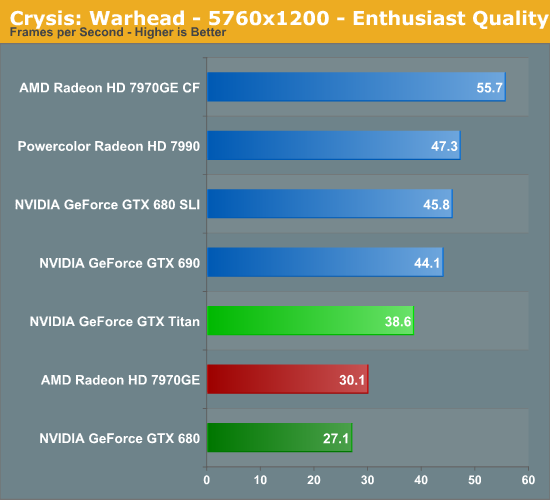

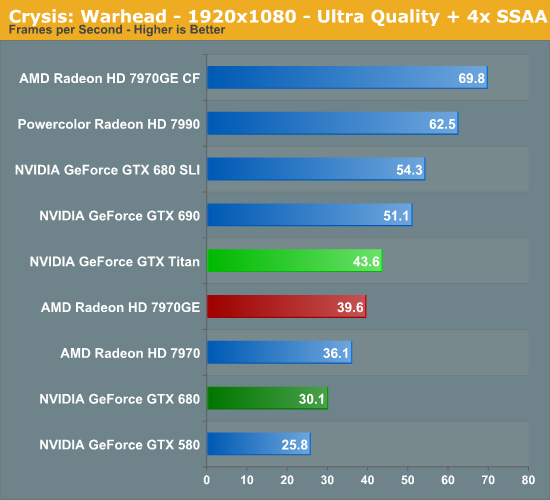

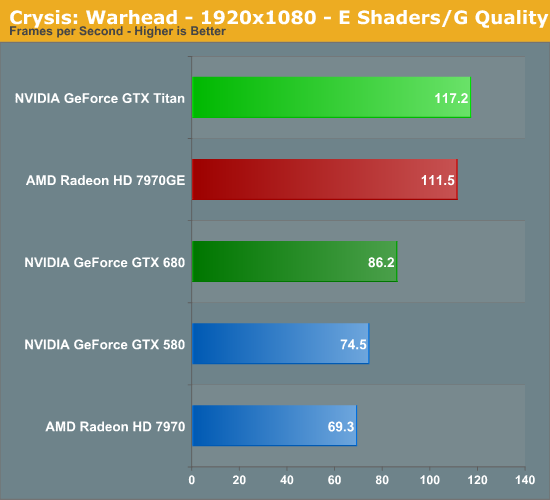
At 2560 we still have a bit of a distance to go before any single-GPU card can crack 60fps. In lieu of that Titan is the winner as expected. Leading the GTX 680 by 54%, this is Titan’s single biggest win over its predecessor, actually exceeding the theoretical performance advantage based on the increase in functional units alone. For some reason GTX 680 never did gain much in the way of performance here versus the GTX 580, and while it’s hard to argue that Titan has reversed that, it has at least corrected some of the problem in order to push more than 50% out.
In the meantime, with GTX 680’s languid performance, this has been a game the latest Radeon cards have regularly cleared. For whatever reason they’re a good match for Crysis, meaning even with all its brawn, Titan can only clear the 7970GE by 21%.
On the other hand, our multi-GPU cards are a mixed bag. Once more Titan loses to both, but the GTX 690 only leads by 15% thanks to GK104’s aforementioned weak Crysis performance. Meanwhile the 7990 takes a larger lead at 33%.
I’d also note that we’ve thrown in a “bonus round” here just to see when Crysis will be playable at 1080p with its highest settings and with 4x SSAA for that picture-perfect experience. As it stands AMD multi-GPU cards can already cross 60fps, but for everything else we’re probably a generation off yet before Crysis is completely and utterly conquered.
Moving on, we once again have minimum framerates for Crysis.
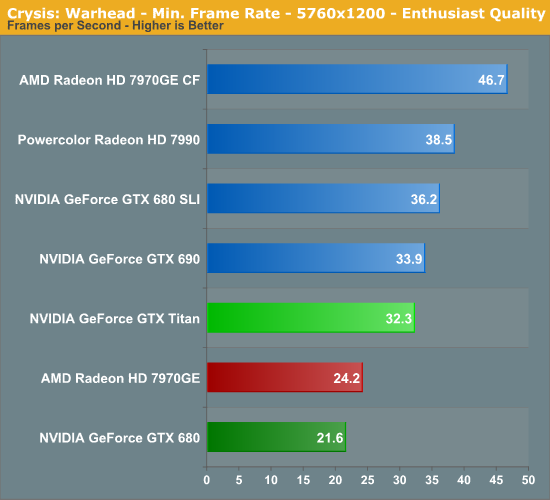
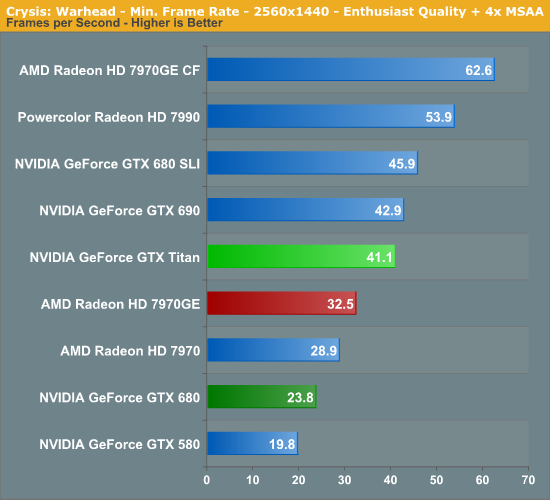
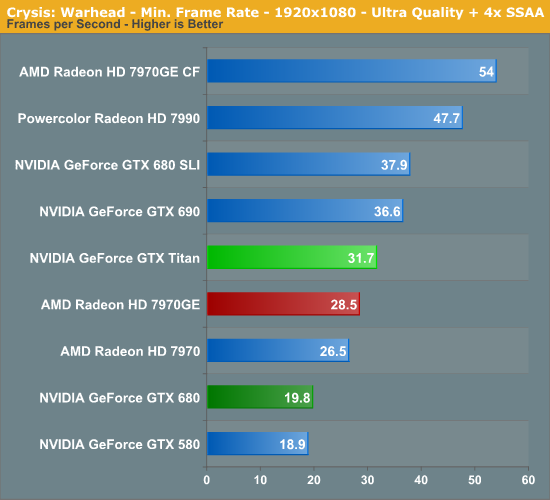
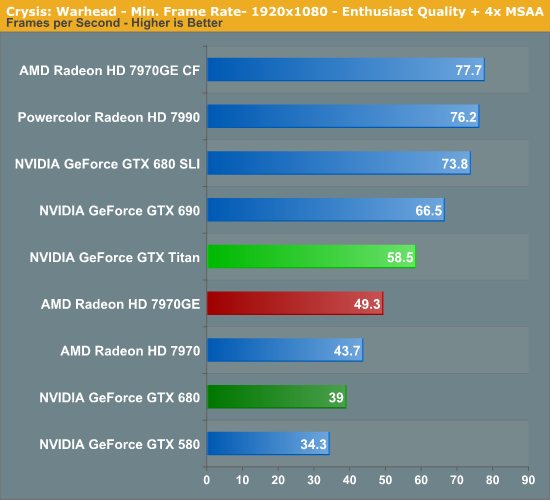
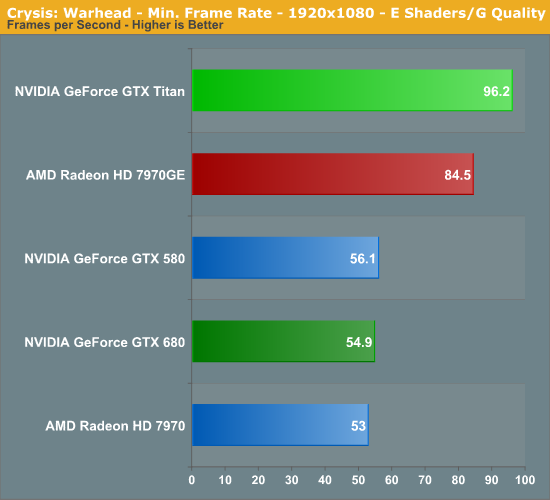
When it comes to Titan, the relative improvement in minimum framerates over GTX 680 is nothing short of obscene. Whatever it was that was holding back GTX 680 is clearly having a hard time slowing down Titan, leading to Titan offering 71% better minimum framerates. There’s clearly much more going on here than just an increase in function units.
Meanwhile, though Titan’s gains here over the 7970GE aren’t quite as high as they were with the GTX 680, the lead over the 7970GE still grows a bit to 26%. As for our mutli-GPU cards, this appears to be a case where SLI is struggling; the GTX 690 is barely faster than Titan here. Though at 31% faster than Titan, the 7990 doesn’t seem to be faltering much.










337 Comments
View All Comments
ronin22 - Thursday, February 21, 2013 - link
That's the point, it's not a gamerz cardFinally - Thursday, February 21, 2013 - link
"Titan delivers the kind of awe-inspiring performance we have come to expect from NVIDIA’s most powerful video cards."If you hear unfiltered Nvidia marketing speak like this, you know that AT isn't fooling around when it comes to earning their PR dollars. Well done!
Scritty - Thursday, February 21, 2013 - link
Paper launch? Fine. I get that. But I suspect stock levels will be seriously limited. Rumour has it that only 10,000 of these will be made - which seems very odd as even with a substantial profit marging - the ROI on development costs is going to be hard to recoup with a potential sales level as low as that.I'm looking to buy a couple of these as soon as they are available for SLI - maybe 3 for a triple set up if possible, but I can see there being real issues with stock. I decent solution 3 screen at 2560x1440 for sure - if you can get hold of them anywhere.
Ryan Smith - Thursday, February 21, 2013 - link
Note that NVIDIA specifically shot down the 10K card rumor. As far as we've been advised and as best as we can tell, card availability will be similar to what we saw with the GTX 690. Which is to say tight at first, but generally available and will continue to be available.Egg - Thursday, February 21, 2013 - link
The chart on page 1 is missing a 'GB' under GTX Titan's VRAM listing. There aren't any 5760*1200 non-GE 7970 benchmarks. Also, on the Power, Temperature, and Noise page, "temperate" should be "temperature" just before the first chart.Additionally, the voltage issue HollyDOL and the strange Crysis Warhead 1080p E Shader/G Quality issue silverblue mentioned should be clarified as well. (I'm just repeating them here so they have a higher chance of being seen.)
Also, Wolfram|Alpha interprets "gigaflops" as "billion floating point operations per second" by default, while offering an alternative interpretation that doesn't have the seconds unit. Wikipedia also defines flops as already having the time unit. By their standards, flops/s is technically incorrect. I'm not scientist, and I actually didn't notice this until typed gigaflops into Wolfram|Alpha, so take this for what little it's worth.
It's silly to suggest that this card needs a voltmod and a waterblock. Very few people doing scientific work are going to be having time to do that. This card isn't intended to be a gaming card. Yes, there undoubtedly will be people on hwbot who would love to do such a thing, but relative to the population of scientists living on meager grants, they're small.
It's also silly to say that Titan is a bad card because it isn't as efficient as other cards at password hashing or bitcoin mining. These embarallel workloads aren't representative of scientific workloads. Besides, the most dedicated people have a custom FPGAs or ASICs for those workloads.
Saying that it shows Nvidia jacking up prices on its flagship is misleading. Yes, it's technically true. But I saw someone say that the GTX 680 was only a "midrange" card. The GTX 680 still competes with the Radeon 7970 GE. It isn't outright winning anymore - in certain games, it loses - and it's often substantially more expensive. But it's still reasonably competitive. Why did anyone expect Titan to push down GTX 680 prices? If anything, it might push down Tesla 20X prices, but I'm not holding my breath.
Would anyone have complained about Nvidia being outrageously greedy if Titan didn't exist in the consumer space at all?
(Moreover, the GTX 580 had FP64 performance at 1/8 FP32 performance, not Titan's 1/3. (http://www.anandtech.com/show/4008/nvidias-geforce...
Simply looking at the specs partially explains why the card is so damn expensive. It's 7.1 billion transistors, compared to the GTX 690's 2*3.5 billion transistors. (Page 1 on this article). Going purely by transistor count, Titan is underpriced, because it's just as expensive as the GTX 690. Looking at die area instead is less forgiving, but don't forget that squeezing 7 billion transistors on a single die is more difficult than having two 3.5 billion transistor dies. Titan also has 2 extra gigabytes of GDDR5.
The only valid criticism I've seen is that Titan can be outperformed by two 7970 GEs in certain, mostly FP32 compute workloads, which are a cheaper solution, especially for scientists who probably aren't as concerned with heat production as those working on the Titan supercomputer. After all, you can fit bigger fans in an EATX case than in most racks. 689 Gflops is still greater than 50% of 1309 Gflops; it's 53%. When you can find the cheapest 7970 GEs at a bit over $400, two 7970s will be about $200 cheaper.
But figure in power: http://www.wolframalpha.com/input/?i=200+W+*+1+yea... . After a year of continuous usage (or two years of 50% utilization), and assuming that two 7970 GEs will use 200 more watts than a Titan - a fairly reasonable estimate in my opinion - Wolfram|Alpha informs us that we'll have saved $216.
Not to mention the fact that two 7970s occupy around twice as much space as a Titan. That means you need more individual systems if you're looking to scale beyond a single workstation.
And finally, anyone who needs as much memory per GPU as they can get will need Titan.
It's hard to draw any real conclusions right now, though, with DirectCompute dubious and OpenCL broken. Great work on Nvidia's part, getting the drivers working...
There's also the fact that Nvidia is marketing this as a gaming card, which is disingenuous and poor practice. But come on, we all read Anandtech for a reason. Overhyped marketing is nothing new in technology.
So in conclusion - treat the GTX 680 as the flagship single-GPU consumer card. (They did call it a 680. See the GTX 580, 480, and 280.) It's in roughly in 7970GE's ballpark when it comes to price and performance. For gamers, Titan can effectively be ignored.
If you need FP32 compute performance, consider multiple 7970 GEs as well as Titan.
If you need FP64 compute performance, Titan is unparalleled, assuming you run it for a decent amount of time.
And if you're trying to set a world record, well, I guess you can pay through the nose for Titan too.
Insomniator - Thursday, February 21, 2013 - link
Thank you, so many here just sound like butt hurt kids that do not understand these concepts or maybe didn't even read the article. Few of them would buy it at the $700 they cry about wanting it to be.This card is not just for gamers, and even if it were, performance wise it crushes the next closest single GPU competitor. Remember when Intel EE editions were $1k? The best always costs extra... and in this case the card isn't even being marketed soley for gamers anyway.
Until AMD puts out a new card that can beat it for cheaper, this will remain a $1k. Until then, the 680, 670, and 660 are all competitive products.
CeriseCogburn - Tuesday, February 26, 2013 - link
Don't expect the crybaby fools to respond. They'd prefer to pretend your post isn't here.If they do say anything, it will just be another repetitious pile of tinfoil hat lies Charlie D will be proud of.
Olaf van der Spek - Thursday, February 21, 2013 - link
Still only average framerates? :(I had hoped you'd move to minimum framerate / max frametime based benchmarking. Averages are (and were) kinda meaningless.
Ryan Smith - Thursday, February 21, 2013 - link
Actually we have some FRAPS data for a few of our games as a trial of some ideas. Unfortunately you won't see it for this article as there simply wasn't enough time to put that together on top of everything else. But keep your eyes peeled.GiantPandaMan - Thursday, February 21, 2013 - link
The Titan was a compute part, first and foremost. Gamers have much better alternatives in the 7970/680 route.Personally I think it's a pretty impressive piece of hardware, though there's no way in hell I'd ever buy it. That's because I'm a value oriented buyer and I don't have that much disposable income.
I just don't get all the indignation and outrage. It's not like nVidia screwed you over in some way. They had an expensive piece of hardware designed for compute and said to themselves, what the hell, why not release it for gamers?